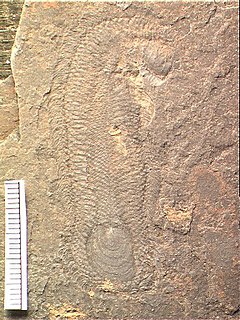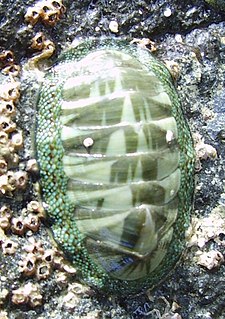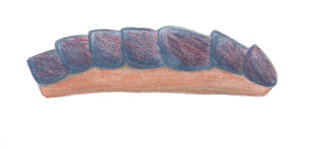Machaeridia is an extinct group of armoured, segmented annelid worms, known from the Early Ordovician to Carboniferous. It consists of three distinct families: the plumulitids, turrilepadids and lepidocoleids.

A sclerite is a hardened body part. In various branches of biology the term is applied to various structures, but not as a rule to vertebrate anatomical features such as bones and teeth. Instead it refers most commonly to the hardened parts of arthropod exoskeletons and the internal spicules of invertebrates such as certain sponges and soft corals. In paleontology, a scleritome is the complete set of sclerites of an organism, often all that is known from fossil invertebrates.

Chitons are marine molluscs of varying size in the class Polyplacophora, formerly known as Amphineura. About 940 extant and 430 fossil species are recognized.

Monoplacophora, meaning "bearing one plate", is a polyphyletic superclass of molluscs with a cap-like shell now living at the bottom of the deep sea. Extant representatives were not recognized as such until 1952; previously they were known only from the fossil record.

Juravenator is a genus of small coelurosaurian theropod dinosaur, which lived in the area which would someday become the top of the Franconian Jura of Germany, about 151 or 152 million years ago. It is known from a single, juvenile specimen.

The halkieriids are a group of fossil organisms from the Lower to Middle Cambrian. Their eponymous genus is Halkieria, which has been found on almost every continent in Lower to Mid Cambrian deposits, forming a large component of the small shelly fossil assemblages. The best known species is Halkieria evangelista, from the North Greenland Sirius Passet Lagerstätte, in which complete specimens were collected on an expedition in 1989. The fossils were described by Simon Conway Morris and John Peel in a short paper in 1990 in the journal Nature. Later a more thorough description was undertaken in 1995 in the journal Philosophical Transactions of the Royal Society of London and wider evolutionary implications were posed.

Odontogriphus is a genus of soft-bodied animals known from middle Cambrian Lagerstätte. Reaching as much as 12.5 centimetres (4.9 in) in length, Odontogriphus is a flat, oval bilaterian which apparently had a single muscular foot, and a "shell" on its back that was moderately rigid but of a material unsuited to fossilization.

Chiton glaucus, common name the green chiton or the blue green chiton, is a species of chiton, a marine polyplacophoran mollusk in the family Chitonidae, the typical chitons. It is the most common chiton species in New Zealand. Chiton glaucus is part of a very primitive group of mollusc with evidence of being present in up to 80 million years of the fossil record.
A mollusc valve is each articulating part of the shell of a mollusc. Each part is known as a valve or in the case of chitons, a "plate". Members of two classes of molluscs: the Bivalvia (clams) and the Polyplacophora (chitons) have valves.

Holonema is an extinct genus of relatively large, barrel-shaped arthrodire placoderms that were found in oceans throughout the world from the Mid to Late Devonian, when the last species perished in the Frasnian-Fammian extinction event. Most species of the genus are known from fragments of the armor, but the Gogo Reef species, H. westolli, is known from whole, articulated specimens. According to these specimens, species of Holonema lived by grazing on stony, horn-shaped, stromatolite-like algae called oncholite, apparently by snipping off the points with a specialized snout.

Chitonidae is a family of chitons or polyplacophorans, marine mollusks whose shell is composed of eight articulating plates or valves. There are fifteen extant genera in three subfamilies.

Acanthopleura granulata, common name the West Indian fuzzy chiton, is a medium-sized tropical species of chiton.
Plumulites canadensis is a member of the machaeridian family and existed from 480 million years ago until about 250 million years ago. This armoured annelid worm is the relative of the modern-day earthworm, leech and bristleworm. Fewer than ten fossils of Plumulites have been found.
The Paleoloricata are valved polyplacophora without sutural laminae or insertion plates. The "order" probably represents a paraphyletic grouping.

Mopaliidae is a family of marine molluscs in the class Polyplacophora.
Acutichiton is among the most primitive genera of Neoloricate chitons. Acutichiton became extinct during the Carboniferous period. Articulated specimens are known.
Glaphurochiton is a genus of fossil chitons known from the Mazon Creek biota. Remarkably, it contains an intact radula, which with 17 teeth per row and over 100 rows is almost identical to the radula of modern chitons . The radula extends from the first to third shell plates.

Kulindroplax perissokomos is a Silurian mollusk, known from a single fossil from the Wenlock Series Lagerstätte fauna of England. It lived during the Homerian Age. It is considered a basal aplacophoran. Unlike all modern aplacophorans, which are shell-less, Kulindroplax has a chiton-like shell, and it is considered a transitional fossil in the evolution of molluscs.

Entelognathus primordialis is a placoderm from the late Ludlow epoch of Qujing, Yunnan, 419 million years ago.












